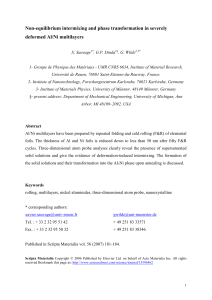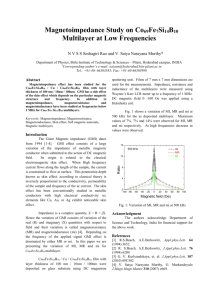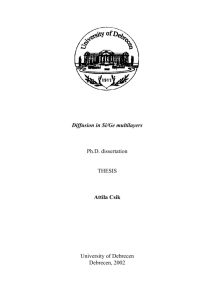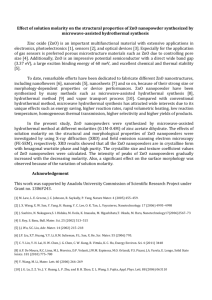Paper reference number: EA8X2 , H-P154
advertisement
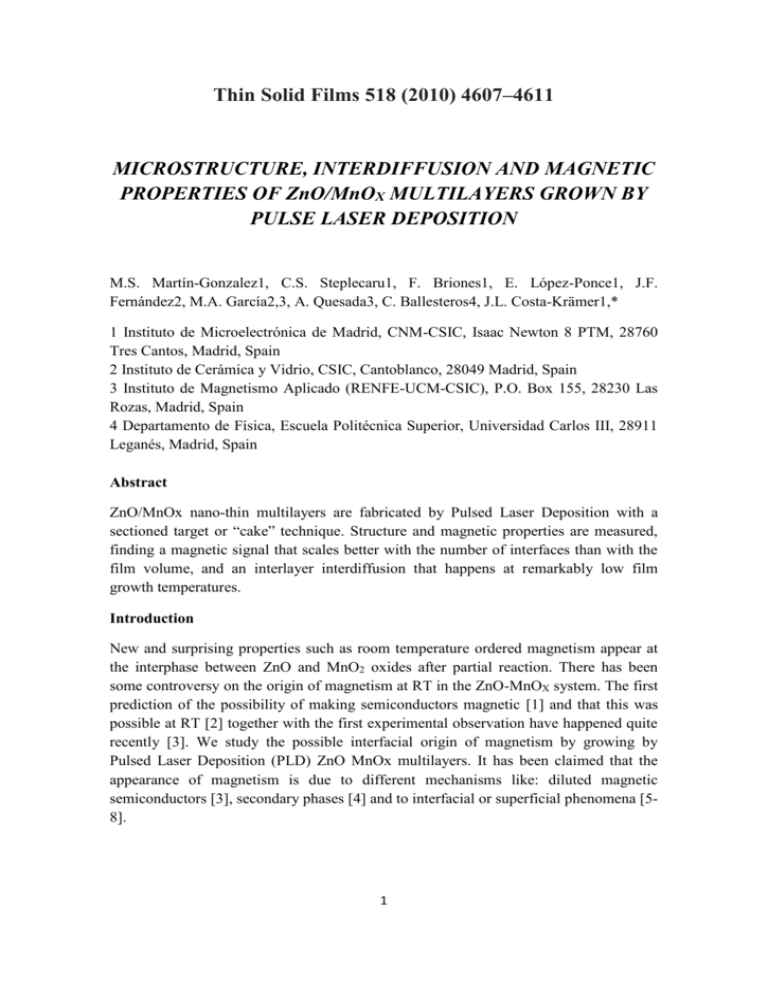
Thin Solid Films 518 (2010) 4607–4611 MICROSTRUCTURE, INTERDIFFUSION AND MAGNETIC PROPERTIES OF ZnO/MnOX MULTILAYERS GROWN BY PULSE LASER DEPOSITION M.S. Martín-Gonzalez1, C.S. Steplecaru1, F. Briones1, E. López-Ponce1, J.F. Fernández2, M.A. García2,3, A. Quesada3, C. Ballesteros4, J.L. Costa-Krämer1,* 1 Instituto de Microelectrónica de Madrid, CNM-CSIC, Isaac Newton 8 PTM, 28760 Tres Cantos, Madrid, Spain 2 Instituto de Cerámica y Vidrio, CSIC, Cantoblanco, 28049 Madrid, Spain 3 Instituto de Magnetismo Aplicado (RENFE-UCM-CSIC), P.O. Box 155, 28230 Las Rozas, Madrid, Spain 4 Departamento de Física, Escuela Politécnica Superior, Universidad Carlos III, 28911 Leganés, Madrid, Spain Abstract ZnO/MnOx nano-thin multilayers are fabricated by Pulsed Laser Deposition with a sectioned target or “cake” technique. Structure and magnetic properties are measured, finding a magnetic signal that scales better with the number of interfaces than with the film volume, and an interlayer interdiffusion that happens at remarkably low film growth temperatures. Introduction New and surprising properties such as room temperature ordered magnetism appear at the interphase between ZnO and MnO2 oxides after partial reaction. There has been some controversy on the origin of magnetism at RT in the ZnO-MnOX system. The first prediction of the possibility of making semiconductors magnetic [1] and that this was possible at RT [2] together with the first experimental observation have happened quite recently [3]. We study the possible interfacial origin of magnetism by growing by Pulsed Laser Deposition (PLD) ZnO MnOx multilayers. It has been claimed that the appearance of magnetism is due to different mechanisms like: diluted magnetic semiconductors [3], secondary phases [4] and to interfacial or superficial phenomena [58]. 1 The multilayers are grown by PLD using a target in the shape of a “cake” with two compositions. Detailed investigations looking for the relationship between microstructure, compositional order, quality, interdiffusion and existing phases in the multilayers are performed by high resolution transmission electron microscopy (HRTEM). Similarly to bulk ceramic oxide mixtures [6,9] it is found that a remarkably low deposition temperature 400ºC is enough to promote a certain degree of interdiffusion between individual layers and the appearance of room temperature ordered magnetism. It is shown that this magnetic signal scales with the number of interfaces in the multilayer. Experimental Pulsed laser deposition (PLD), was recognized as a process to deposit metal-oxide films, such as ZnO in the 80s [10], although the first thin film deposition experiments were carried out in 1965 by Smith and Turner [11]. Our home-made PLD system introduces a wedge-target for the deposition of multilayers (see Fig.1). This target configuration allows the growth of homogeneous thin films (Fig.1 left) bilayers (Fig. 1 center) and multilayers with individual nanometer thin layers (Fig.1 right) under the same chamber. The target for multilayers consists of two or more materials and is used for the deposition of complex individual thin layer oxide multilayer structures by PLD. The target structure is similar to a “cake” (see Fig. 1 right) built with portions of different “flavors” that are transferred by PLD to an oxide thin film multilayer. The periodicity of the films is controlled by the laser repetition rate, target rotation speed, and the laser spot energy on the target. Wedge, sectored or split targets have previously been used in PLD processes for depositing monolithic films of variable composition [12-14]. In these cases, the authors used split targets to grow monolithic films of Pb(Zr0.48Ti0.52)O3 (PZT), Pb(Mg0.33Nb0.66)O3]-[PbTiO3]x, and BaxSr1–xTiO3 of different compositions by varying the amount of materials ablated from each side of the split targets. They chose conditions that resulted in uniform compositions throughout the film by growing at relatively slow rates and post-annealing. The systematic shifts in Xray diffraction measurements of diffraction peak positions show that the conditions used for deposition resulted in monolithic films rather than multilayers. An additional benefit of using the split targets in these experiments was the ability to compensate for the resputtering of Pb from energetic neutrals and ions from the laser plume [15]. Our thin film multilayers are deposited by pulsed-laser deposition on (001) silicon single-crystal substrates.[16] Multilayers are grown by alternating MnO2 and ZnO ceramic targets prepared by ceramic method and sintered at 500 °C for 12h. Targets were ablated using a Lambda Physik laser (model LPX 205i MC) operated (λ=193 nm) at a pulse repetition rate of 10Hz, ~150-200 mJ per pulse, a pulse duration of 17 ns, and a target rotation in the range 1-2 rpm. Multilayers were deposited at an oxygen pressure of 2.10-1 mbar and a substrate temperature of 400 °C. Different number of multilayers 2 and bilayer thicknesses were prepared for comparison purposes. The structural characterization of the thin films and multilayers were carried out by XRD analysis in a PHILIPS diffractometer using a Cu Kα line. The thicknesses and uniformity of the films were measured using a Talystep profilometer and Atomic Force Microscopy. Magnetic measurements were carried out over a temperature range of 2.5–300 K on a Quantum Design SQUID magnetometer. When performing the magnetic measurements, all possible sources of spurious signals described in [17] were considered and avoided. Cross-sectional specimens suitable for transmission electron microscopy (TEM) were prepared by standard procedures: mechanical grinding, dimpling and argon ion milling in a liquid-nitrogen-cooled holder with an acceleration voltage of 5 kV and an incidence angle of 8º. The selected area electron diffraction pattern (SAEDP), energy-dispersive x-ray analysis, TEM and High Resolution Transmission Electron Microscopy (HRTEM) images were carry out using a Philips Tecnai 20F FEG analytical microscope operating at 200 kV equipped with a dark field high angle annular detector (HAAD) for Z-contrast analysis. Results and discussion Figure 1 shows the three different target configurations used for PLD deposition. First, a single target: a ceramic mixture of ZnO and MnO2, second: ZnO (top) and MnO2 (bottom) targets for thick multilayer growth, and third “cake” pellet of ZnO and MnO2 for thin layers multilayer growth. These targets are used to grow homogeneous thin films, thick individual multilayer (mostly bilayers) and nanometers thin layer multilayers, respectively. All these target configurations are used to investigate the origin of magnetic signals in oxide mixtures and thin oxide films and heterostructures [5,6] An example of cross-sectional bright field images oriented along the <110> direction of the Si-substrate of a multilayer composed of 26 bilayers ZnO/MnOX together with dark field HAAD image with compositional Z-contrast is shown on figure 2 a and b. In this particular case, the multilayers growth was stopped in the MnO2 target and a thick layer of MnOx were grown in between two ZnO layers to confirm the Z-contrast and determine which of the several possible Mn-O phases was growing. The measurements in Å, taking form the SAEDP, in the thick central area of the MnOx are summarized in table I. All the distances measured could be indexed with Mn3O4 a=3.026, b=9.769 y c=9.568, JCPDS 750565. The multilayer is grown on silicon (100) by using a deposition time of 30 seconds by layer, except the thick Mn3O4 layer in the middle that was grown for 9 min. The total thickness measured at the TEM images was 194 nm, in good agreement with the thickness measured by a talystep profilometer) 3 The multilayer presents a good morphology with good lateral uniformity, periodicity and with a clear definition of the individual layers. The contrast along the individual layer is associated with their polycrystalline structure, as it was confirmed by SAEDP and electron nanodiffraction patterns. The roughness of the layers increases with increasing the distance from the Si-substrate, the maximum roughness measured from HRTEM images was 3 nm. The layer thicknesses are in the nanometer range, 5 nm for ZnO and 1.5 nm for MnOx (around 19 and 5 unit cells, respectively). Since the laser power conditions are the same this means that the deposition rate of ZnO is about 3 times larger than that of MnOx under these conditions. To investigate the composition of the layers and the compositional order STEM dark field Z-contrast images have been obtained, see figure 2b. Those images indicate a compositional order along the superlattices. In Z-contrast, lighter atoms appear with darker contrast. Compositional mappings were also made after the EDX spectra associated with the STEM images, where the Mn and Zn distribution along the layers are imaged, using the Mn and Zn Kα lines of the EDX spectra respectively. The compositional mappings give a direct indication of the presence of each compound in each multilayer. In this case, the mapping of the thick Mn3O4 layer is also shown for clarification. Although it is clear the presence of ZnO and Mn3O4 layers, a small interdiffusion could be also taking place. A magnification of the multilayer structure is shown in figure 3. The contrast is defined by the (002) ZnO lattice fringes. Disorder and different thickness is observed at the interfaces indicating a non regular distribution of the Mn oxide as it is also observed in the EDX mappings. And a columnar growth of the multilayer is observed. A high resolution TEM image of the ZnO layer is also shown in the insert of figure 3b together with the corresponding fft electron diffraction simulation. According with the distances measured the ZnO (001) axis is perpendicular to the substrate surface. In order to investigate the individual layer composition and if a diffusion process takes place between the multilayers a low magnification SAEDP was performed. The oriented monocrystalline spot pattern of the (110) Si-substrate plane was used as an internal calibration. A typical SAEDP pattern obtained is shown in figure 3c, and the main distances obtained from the measurements are summarized and compared with the expected values for the compounds as shown in table II. The diffraction patterns consist of hazy rings from the polycrystalline phase and relatively sharp and weaker diffraction spots from individual nanocrystals. With the resolution achieved, the distances corresponding to Mn3O4, ZnO and ZnXMn2+XO4 can be identified. The appearance of the new spinel ZnXMn2+XO4 phase can only be explained by the intermixing produced between ZnO and Mn3O4 layers at 400ºC. So, it can be claimed that multilayers interdiffusion is found at lower temperatures than expected (400ºC) as compared with 4 solid-state methods.[8] Since it is a diffusion controlled process the amount of ZnXMn2+XO4 will depend on the time that the multilayers is at 400ºC. So an important parameter that should be taken into account to reduce the intermixing of the layers is the total deposition time. Figure 4 shows the magnetic signal for two multilayers grown with the same number of individual layers, but with nominally double thicknesses. Both multilayers are composed of 40 bilayers ZnO/Mn3O4. The multilayer B187A measured thicknesses is 70 nm and B207A is 200 nm. Fig. 4a shows the measured magnetic moment per unit volume, and fig 4 b shows the measured magnetic moment. Remarkably, both multilayers have similar magnetic moments, but the magnetic moment per unit volume is smaller for the thick multilayer film. This experimental fact points to a magnetic signal that scales with the number of interfaces in the multilayer and not with the film volume, strongly suggesting an interfacial origin of the room temperature ferromagnetism-like behavour. [5,6] Summarizing the above experimental data, it turns out that even at low temperature film deposition there is a certain degree of interdiffusion and ordered magnetic properties appear, at the interface between two oxides. One is diamagnetic, ZnO, and the other paramagnetic Mn3O4 in their bulk forms. The thicknesses of the layers are such that ZnO, Manganese Oxide, and an incipient Manganese Zinc spinel phase are resolved. It is then concluded that a crucial parameter to be taken into account in order to explain the variety of results of the magnetic measurements in multilayers is the control of the interdiffusion. In order to confirm this hypothesis, short period multilayer (using 20s per layer) were grown at 400ºC with the same laser conditions as before. When the multilayers are not thick enough, figure 5, a complete interdiffusion occurs during growth at 400ºC in the layers close to the substrate surface. Three different areas can be observed. 1) In the area closest to the substrate surface there is not multilayers pattern, see figure 5c. Only a polycrystalline structure is observed, as corroborated by TEM. The SAEDP patterns (not shown), indicate the presence of the mixed oxide (ZnxMn2+xO4) together with small amount of ZnO and Mn3O4 coming from the top layers that did not have enough time to interdiffuse and they are still observed, see figure 5b. 2) In the top part of the film good morphology multilayer of approximate 1.1 nm Mn3O4 and 3.9 nm ZnO layers can be measured, see top part of figure 5b. And, 3) in between those two part (middle of the film) an important interdiffusion as is shown, see the bottom part of figure 5b. In figure 5d a sketch of the diffusion model can be found. In summary, the first multilayers, the one close to the substrate, have already reacted and form the ZnxMn2+xO4 phase. While in the few top multilayers the diffusion has not yet occur totally and a few of discontinuous multilayers can still be differentiated. 5 The disappearance of the Mn3O4 phase can also be followed by XRD, see figure 6. For the thicker multilayers (for deposition time per layer over 30 s) three phases can be detected in the diffraction pattern ZnO, Mn3O4 and ZnxMn2+xO4. While for the thinner multilayers (time of less than 20 s per layer) the Mn3O4 diffraction maxima disappear and only ZnO and ZnxMn2+xO4 could be detected. Then, in order to control the interdiffusion and to grow good quality multilayers three parameters play an important role (growth temperature, layer thicknesses and total deposition time at high temperature). These facts are also illustrated in figure 5, where a multilayer structure is observed only in the top multilayers, while the multilayers close to the substrate have already reacted to form ZnXMn2+XO4. This happens as the growth of the top multilayers proceeds. If the individual layers are too thin, or the deposition time is too long, or the deposition temperature is too high, interdiffusion takes place and the multilayers react to form a new compound. This is important to define the optimal growth conditions to obtain high quality multilayers Conclusions ZnO MnO2 thin film oxide multilayers are grown by PLD using “cake” targets. The multilayer is made of two oxides, one is diamagnetic, ZnO, and the other paramagnetic Mn3O4 in their bulk forms. The ZnO PLD yield is about 4-5 times that of MnO2 target. Our results indicate that the magnetic signal in ZnO-MnOX oxide multilayers scale with the number of interfaces. Structural studies show that even at very low deposition temperatures (400ºC) an interdiffusion between the ZnO and the MnOX layers occurs, that eventually can produce an incipient ZnXMn2+XO4 spinel. Since is not possible to growth the multilayers without a certain temperature, it is very important to optimize the layer thickness, total number of multilayers and the total deposition time, to control or minimize the interdiffusion, in order to obtain good quality interfaces between the two different oxides. Since a non-optimized process will promote the inter-reaction or inter-diffusion between layers and the multilayer will no longer exist. It is then demonstrated that even at temperatures as low as 400ºC inter reaction occurs, well below the one expected in bulk form. There is a certain degree of interdiffusion. Room temperature magnetic ordered properties appear only when the interdiffusion is controlled and interfaces are present. Acknowledgements The authors gratefully acknowledge financial support from CSIC under projects CSIC: PIF CSIC 2006-50F0122, CSIC 2007-50I015 and from the Spanish “Ministerio de Ciencia y Tecnología” MAT2008-06330. TEM work has been done at the LABMET, associated to the network Red de Laboratorios of the CAM. 6 References [1] H. Ohno, Science, 281, 951 (1998) [2] T. Dietl et al. , Science, 287, 1019 (200) [3] P. Sharma et al. , Nature Mater, 2, 673(2003). [4] D. Kundaliya et al., Nature Mater, 3, 709 (2004) [5] M. A. García et al., Phys. Rev. Lett., 94 , 217206 (2005). [6] A. Quesada, J. Appl. Phys. 100, 113909 (2006) [7] M. S. Martín-González, J. Appl. Phys. 103, 083905 (2008) [8] J.F. Fernandez J. European Cer. Soc. 2006 26 3017 [9] J. L. Costa-Krämer et al., Nanotechnology 16, 214 (2005) [10] H. Sankur, J. T. Cheung, J. Vac. Sci. Technol. A 1983, 1, 1806. [11] H. M. Smith and A. F. Turner, Appl. Opt. 4, 147 (1965) [12] S. K. Hau, K. H. Wong, P. W. Chan, C. L. Choy, Appl. Phys. Lett. 1995, 66, 245. // [13] W. M. Yu, K. H. Wong, Integr. Ferroelectrics 2003, 55, 947. // [14] V. Ruckenbauer, F. F. Hau, S. G. Lu, K. M. Yeung, C. L. Mak, K. H.Wong, Appl. Phys. A 2004, 78, 1049 [15] S. K. Hau, K. H. Wong, P. W. Chan, C. L. Choy, Appl. Phys. Lett. 1995, 66, 245. [16] E. López-Ponce, et al. Jpn. J. Appl. Phys. 45, 7667 (2006) [17] A. García, E. Fernández Pinel, J. de la Venta, A. Quesada, V. Bouzas, J. F. Fernández, J. J. Romero, M. S. Martín González, and J. L. Costa-Krämer J. Appl. Phys. 2009, 105, 013925 7 Interplanars distances measured at the thick central area. Mn3O4 4.87 4.88 (020) 2.84 2.89 (110) 2.68 2.67 (023) 2.75 2.76 (111) a=3.026, b=9.769 y c=9.568 JCPDS 750565 2.73 1.76 1.76 (142) 1.68 1.70 (044) 1.61 1.61 (151) 1.36 1.358 (231) 1.372 (230) Table I. Experimental interplanar distances measures when the SAED pattern is taken only from Mn3O4 central thick layer. 8 Distances measured SADP (Å) 4.87 4.36 3.85 (Si) 3.1 2.86 2.8 2.79 2.75 2.72(Si) 2.68 2.48 Mn3O4 (Å) in JCPDS= 750765 1.6 1.52 1.49 1.48 1.45 1.44 1.41 1.37 1.37 1.36 1.3 1.23 1.2 1.1 4.88 (020) 4.35 (021) 4.87 (101) 3.02 (100) 2.89 (110) 3.05 (112) 2.86 (200) 2.81 (100) 2.77 (111) 2.715 (103) 2.48 (101) 2.3 2.03 2 1.73 1.63 ZnO (Å) rings ZnxMn2+xO4 JCPDS=760704 (Å) JCPDS=241133 2.67 (023) 2.48 (121) 2.47 (112) 2.47 (211) 2.31 (004) 2.02 (220) 2.01 (132) 1.76 (105) 1.63 (110) 1.64 (150) 1.62 (303) 1.61 (151) 1.52 (224) 1.49 (210) 1.48 (103) 1.45 (063) 1.44 (116) 1.41 (200) 1.38 (112) 1.36 (201) 1.30 (004) 1.24 (202) 1.2 (104) 1.1 (203) 1.37 (230) 1.36 (231) Table II. Summary for the experimental interplanar distances from the ZnO/Mn3O4 multilayers compared with the expected values for the compounds present in the multilayers. The (110) Si substrate and are used as an internal calibration. 9 Figure captions Figure 1: Three different target configurations used for PLD deposition. First, ceramic mixture of ZnO and MnO2, second: ZnO (top) and MnO2 (bottom) targets for thick multilayer growth, third “cake” pellet of ZnO and MnO2 for thin multilayer growth Figure 2: Cross sectional images oriented along <110> direction of the Si substrate. a) STEM dark field Z-contrast image, lighter atoms exhibit darker contrast b) bright field image and c) magnified Z-contrast image at the center and EDX compositional mapping, showing the distribution of Mn and Zn kα lines Figure 3: a) High resolution TEM image of the multilayer and FFT electron diffraction simulation of the multilayers. The contrast is defined by the lattice fringes of (002)ZnO. b) Higher magnification images, at the inset: selected area and FFT corresponding to (020)-ZnO. C) Selected Area Diffraction Patterns (SADP). The larger black dots, corresponding to more intense diffracted beams represent the (110) Si-substrate and are used as an internal calibration. De distances are measured in Å and are interpreted in table 1. Figure 4: Magnetic signals for two multilayers grown with the same number of individual layers but with nominally double thicknesses. Both multilayers are composed of 40 bilayers ZnO/MnOx. The multilayer B187A measured thicknesses is 70 nm and B207A is 200 nm. Fig. 3a shows the measured magnetic moment per unit volume, and fig 3 b shows the measured magnetic moment. Figure 5: Interdiffusion model: Top left image is a TEM image of the multilayer, with magnifications of the multilayer structure close to the surface (top right) and to the substrate (bottom right). The sketch at the bottom left illustrates the different structures along the growth direction due to different degrees of interlayer diffusion. 10 Figure 6: X-ray diffraction pattern of two samples one with long period multilayers where ZnO, Mn3O4 and ZnxMn2+xO4 can be clearly observed and one short period multilayers where only ZnO and ZnxMn2+xO4 can be detected. The different diffraction maxima have been indexed. Figure 1 Figure 2 11 c) Fig. 3 12 b) B207A B187A 10 B207A B187A -5 3,0x10 3 M (emu/cm ) a) -5 5 M (emu) 1,5x10 0 0,0 -5 -1,5x10 -5 -5 -3,0x10 -10 -10000 -5000 0 5000 10000 H (Oe) Fig. 4 13 -10000 -5000 0 H (Oe) 5000 10000 Fig. 5 2 2x10 I (cps) Si(002) Mn3O4(023) ZnO(002) long period multilayers short period multilayers Zn1-xMn2+xO4(103) 2 1x10 Zn1-xMn2+xO4(211) 0 30 32 34 36 38 2 (deg) Fig. 6 14



